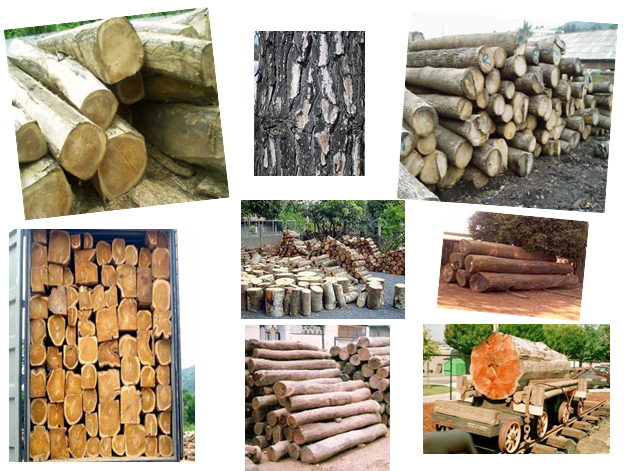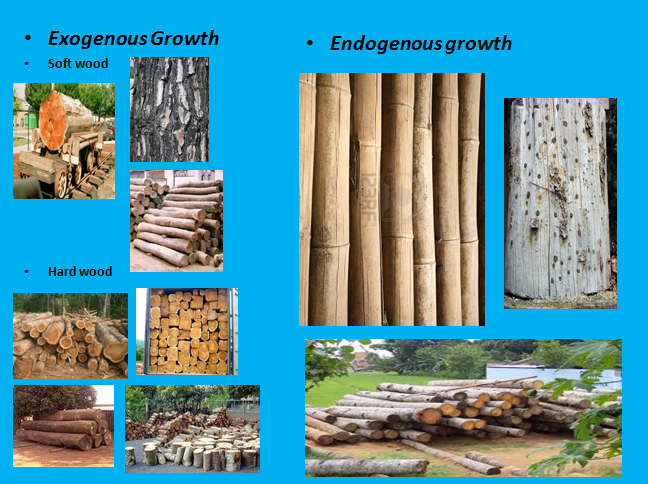A tree consists of three parts (i.e. roots, trunk and leaves). In spring season the required food is absorbed through the roots from the soil. The food is in the form of sap.
Sap consists of a dilute solution of mineral salts. The sap rises to leaves through the cells to give food to them. The leaves give up the moisture from sap and carbon dioxide is absorbed by the leaves. Under direct sun, the carbon dioxide forms a dense chemical compound. This dense sap flows towards the autumn and is deposited under the bark to form a hard layer. This process repeats in number of times.
The growth of trees is of two types:
1. Exogenous growth
2. Endogenous growth
Exogenous growth is that in which trees grow outward from the center adding layer of fresh wood every year that is called as annual rings. This tree is used for all construction and other commercial use. The exogenous growth is further divided into conifers or soft wood examples Pine, deodar, chir, kail, toon etc. or hard wood examples shisham, sal, Teak, Oak, mango, neem, babool etc.
Endogenous growth the layers are added on the inner side of the tree example are bamboo, coconut, cane etc.
STRUCTURE OF WOOD
Pith or medulla:
It is the central part of the tree. If feeds of the sap from roots to leaves. It has a dark colour. Annual rings are added to the timber every year.Heart wood:
The portion surrounding the pitch is called heart wood. The percentage of moisture is less in it than the central part. This portion is dark in color and it is very hard and dense and it is the best portion of the wood.Sap wood:
The part of trunk between the heart wood and cambium layer is known as sap wood. It is light in weight, softer and weaker part. It consists of high percentage of moisture due to this the wood is prone to defects so it is not used for commercial purposes. It is generally used as fuel wood.Cambium layer:
The rings adjacent to the bark are known as cambium layer. It has cellular structure and after sometime it is converted into sap wood.Bark:
The outer surface of the tree which act as a cover for the inner portion is known as bark. It protects the tree from insects and frosts.Medullary rays:
These are radial layers starting from pith up to the cambium layer. These rays function to bind the annual rings together. Also it carries sap to various portion of the tree.Annual rings:
These are concentric layers of wood around the pith. Every year one such layer is added to the trunk of the tree.QUALITIES OF GOOD TIMBER
1. It should be free from all types of defects.
2. The wood obtained from the pith portion should be used as is always better than the other parts of the tree.3. It should have straight fibres.
4. It should have regular annual rings.
5. It should be durable and heavy.
6. It should have dark color.
7. It should give a clear sound while striking.
8. It should give light surface while machining.
9. It should have resistance to fire.
10. It should not twist after seasoning.
11. It should be free from all knots.
12. It should give sweet smell.
13. It should be easy to work.
14. It should not resist the stroke of saw while sawing.
15. It should be free from decay.
MARKETABLE FORMS OF TIMBER
LOG:
It is the trunk of tree free from branches and shapes.BALK:
Log sawn into different workable sizes.POST:
Large sized piece of timber. The post is available in round and square cross sections having diameter or side between 200 mm to 300 mm.PLANK:
It is a sawn flat having width 250-275 mmThickness 50-150 mm
Length 2.5-7 metres









No comments:
Post a Comment